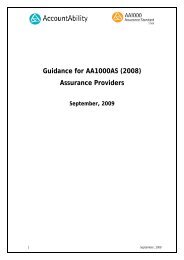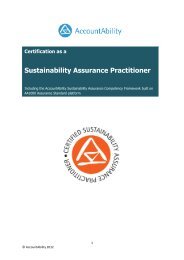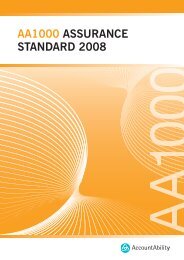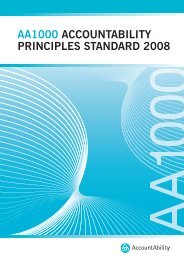The Stakeholder Engagement Manual Volume 2 - AccountAbility
The Stakeholder Engagement Manual Volume 2 - AccountAbility
The Stakeholder Engagement Manual Volume 2 - AccountAbility
Create successful ePaper yourself
Turn your PDF publications into a flip-book with our unique Google optimized e-Paper software.
Take action and review the engagement<br />
P16: CREATING A PLAN FOR ACTION<br />
SMART Targets<br />
S Specifi c – state what exactly is to be achieved.<br />
M Measurable – so that it is possible to determine whether or how far it has<br />
been achieved.<br />
A Achievable – realistic given the circumstances and resources.<br />
R Relevant – to the overall objective/strategy, to the stakeholders, and to the<br />
people responsible for achieving them.<br />
T Time-specifi c - realistic time-frames for achievement.<br />
SMART targets set out what’s going to happen, who’s going to do it, when it’s going to be<br />
done by, and how achievement will be measured.<br />
Key to setting smart targets is ownership. As the targets are intended to assure stakeholders<br />
of your business responsiveness, you should try and seek their consent to them. This may<br />
sometimes, but not always, be possible during the engagement process. Sometimes people<br />
who need to have a say on the targets are not directly involved in the engagement process.<br />
In this case, make sure you report and feedback decisions on your targets (see following<br />
section on reporting).<br />
SUGGESTED METHODOLOGY M16:<br />
CREATING A PLAN FOR ACTION<br />
Th e purpose of this activity is to develop a plan for translating insights, information and<br />
agreements into action, and to ensure that this is monitored and can be reported on.<br />
Use the Template T16 to capture the results of this process.<br />
• Put together a group of internal participants who have been involved in the<br />
engagement process, and who are able to either take decisions on next steps,<br />
or have access to those that make these decisions. Revisit the outcomes of the<br />
engagement in a team meeting or workshop, and collate an overview of them.<br />
In doing this, ask yourself the following question:<br />
Considering our strategic objectives for the engagement (see engagement plan),<br />
what outcomes have we achieved?<br />
• Identify which operational and strategic implications this potentially has, and<br />
assign responsibilities for follow-up on this output.<br />
• Identify the next step(s), which may already have been agreed with stakeholders,<br />
and decide when these are to be delivered.<br />
• Identify any remaining questions or resulting issues that need to be addressed in<br />
subsequent engagement processes. Again, decide who is responsible for taking<br />
this further.<br />
• If there are actions which you and your business needs to deliver on, set<br />
SMART targets.<br />
• Assign responsibilities for implementing and monitoring the follow-up<br />
activities.<br />
• Make sure that information which could be of value to others within your<br />
organisation is communicated to them in an appropriate manner.<br />
• Communicate back to stakeholders appropriately.

















